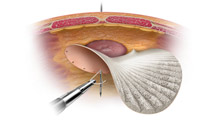Inguinal Hernia Surgery

An inguinal hernia happens when a weakness in the muscle of the groin allows the intestine to bulge through. The first sign of an inguinal hernia is usually an unexplained bulge in the groin area. Inguinal hernias are dangerous because they tend to keep getting larger and your intestine can get trapped inside the bulge and lose its blood supply. Surgery may be needed to correct the problem.
Inguinal hernias may occur on one or both sides of the body and are much more common in men than women. An inguinal hernia can appear at any age. Infants may be born with one that doesn’t show up until they become adults. About five out of every 100 children are born with the condition.
An inguinal hernia can also develop over time if you increase pressure on the walls of your abdominal muscles through activities like straining to go to the bathroom, chronic coughing, being overweight, or lifting heavy weights. If you have a family history of inguinal hernia, you may be at a higher risk for one. Infants born before their due date are also at higher risk.
An inguinal hernia will not heal by itself and does require surgery to be repaired. Once anesthesia is given, surgery begins with an incision on either side of the hernia. A laparoscope is inserted in to one incision, and the other incision is used for additional surgical instruments. If the defect in the muscle is small, it may be sutured closed. The sutures will remain in place permanently, preventing the hernia from returning. For large defects, a mesh graft will be used to cover the hole. The mesh is permanent and prevents the hernia from returning, even though the defect remains open.
